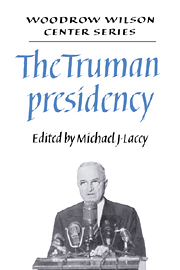Book contents
- Frontmatter
- Contents
- Acknowledgments
- Introduction and summary: The Truman era in retrospect
- 1 The mind and character of Harry S. Truman
- Part I Domestic politics and issues
- 2 Forging America's postwar order: domestic politics and political economy in the age of Truman
- 3 Attitudes toward industry in the Truman administration: the macroeconomic origins of microeconomic policy
- 4 Labor in the Truman era: origins of the “private welfare state”
- 5 Postwar American society: dissent and social reform
- 6 “Some sort of peace”: President Truman, the American people, and the atomic bomb
- Part II Foreign policy and national defense
- About the authors
- Index
4 - Labor in the Truman era: origins of the “private welfare state”
Published online by Cambridge University Press: 06 October 2009
- Frontmatter
- Contents
- Acknowledgments
- Introduction and summary: The Truman era in retrospect
- 1 The mind and character of Harry S. Truman
- Part I Domestic politics and issues
- 2 Forging America's postwar order: domestic politics and political economy in the age of Truman
- 3 Attitudes toward industry in the Truman administration: the macroeconomic origins of microeconomic policy
- 4 Labor in the Truman era: origins of the “private welfare state”
- 5 Postwar American society: dissent and social reform
- 6 “Some sort of peace”: President Truman, the American people, and the atomic bomb
- Part II Foreign policy and national defense
- About the authors
- Index
Summary
Stranded somewhere between the activism of the New Deal and the bureaucratic routine of the Eisenhower years, the labor politics of the Truman era has seemed a chaotic interregnum. In the minefield of postwar reconversion politics, the new president floundered, unable to prevent either a massive strike wave or a surge of inflation. And when Truman did act decisively, as in his veto of the Taft-Hartley Act in 1947 and his seizure of the steel mills during a 1952 strike, he was repudiated either by the Congress or the Supreme Court. These failures were compounded by the defeat of most of his Fair Deal social program and of his effort to repeal Taft-Hartley. Finally, Truman's personal relations with the powerful trade union leaders of the era were erratic: bitter in 1946, cordial during the presidential campaign, chilly again during the Korean War.
But such a seemingly dismal record belies the historical import of the Truman years, for it was under his administration that the experimentation of the New Deal era ended and a remarkably stable settlement that would govern the relationship among capital, labor, and the state became part of the unwritten constitution of the postwar United States. The turning point came between 1946 and 1948 when a still-powerful trade union movement found its efforts to bargain over the shape of the postwar political economy decisively blocked by a powerful remobilization of business and conservative forces whose collective strength weighed heavily on the man who occupied the Oval Office.
- Type
- Chapter
- Information
- The Truman Presidency , pp. 128 - 155Publisher: Cambridge University PressPrint publication year: 1989
- 9
- Cited by



